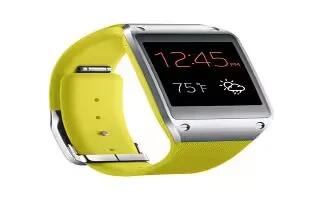How To Use Pedometer – Samsung Galaxy Gear

Learn how to use pedometer on your Samsung Galaxy Gear. Use this as a wellness application that allows you to better manage your health by managing your step counts.
- From the Home (Clock) screen, scroll to and then tap Apps > Pedometer.
- Tap Start.
To create a User Profile:
- From the main Pedometer app screen, tap Menu icon to configure the application.
- Select User profile and begin to update the values as needed.
- Gender: choose from either Male or Female.
- Height: make adjustments using the on-screen dial. Tap ft,in to then change the measurement units to either cm or ft,in. Tap OK to save the new setting.
- Weight: make adjustments using the on-screen dial. Tap lb to then change the measurement units to either kg or lb. Tap OK to save the new setting.
- Units (dist.): choose from either km or Miles.
To configure the Pedometer application:
- From the main Pedometer app screen, tap Menu icon to configure the application.
- Tap the Goal field to assign a step count, tap + or – to adjust the value. Tap OK to save the newsetting.
- Tap Reset steps to reset your current step count.
- Tap Send to S Health to send your current Pedometer information to the S Health application on your paired smartphone.
- Tap User profile to configure the application with your personalized information.
- Tap Feedback to allow form end-user feedback of the application.
- Tap Reset to reset not only the pedometer count but also the main application.
- Tap Help to view on-screen help information.
Before You Start Exercising
This app can be used to monitor your exercise. While moderate physical activity, such as brisk walking, is safe for most people, health experts suggest that you talk with your doctor before you start an exercise program, particularly if you have any of the following conditions:
- Heart disease;
- Asthma or lung disease;
- Diabetes, or liver or kidney disease;
- Arthritis.
You should also check with your doctor if you have symptoms suggestive of heart, lung, or other serious disease, such as:
- Pain or discomfort in your chest, neck, jaw, or arms during physical activity;
- Dizziness or loss of consciousness;
- Shortness of breath with mild exertion or at rest, or when lying down or going to bed;
- Ankle swelling, especially at night;
- A heart murmur or a rapid or pronounced heartbeat;
- Muscle pain when walking upstairs or up a hill that goes away when you rest. Finally, the American College of Sports Medicine recommends that you see your doctor before engaging in vigorous exercise if two or more of the following apply:
- You are a man older than age 45 or a woman older than age 55;
- You have a family history of heart disease before age 55;
- You smoke or quit smoking in the past six months;
- You have not exercised for three months or more;
- You are overweight or obese;
- You have high blood pressure or high cholesterol.
- You have impaired glucose tolerance, also called pre-diabetes.
When in Doubt – Check it Out
If you are unsure of your health status, have several health problems, or are pregnant, you should speak with your doctor before starting a new exercise program. Working with your doctor ahead of time is a good way to plan an exercise program that is right and safe for you. Consider it the first step on your path to physical fitness.









 RSS - All Posts
RSS - All Posts